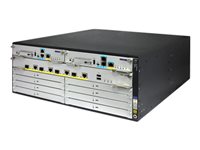| Marketing Description |
| The HPE MSR4000 router series supports HPE FlexBranch solution as part HPE's overall comprehensive HPE FlexNetwork architecture. It features a modular design that delivers unmatched application services for extra large branch offices, headquarters and campus, while reducing complexity, simplifying configuration, deployment and management. The MSR4000 router series provides a full-featured, resilient routing platform, including IPv6 and MPLS, up to 20 Mpps forwarding capacity and 8 Gbps of IPsec VPN encrypted throughput. The MSR4000 router series leverages separated data and control planes, dual MPUs (main processing units) and support for up to four power supplies ensuring the highest performance and reliability. |
| Product Features |
- Excellent forwarding performance
Provides forwarding performance up to 5 Mpps (3.3 Gbps); meets the bandwidth-intensive application demands of enterprise businesses.
- Powerful security capacity
Includes an embedded hardware encryption accelerator to improve encryption performance; IPSec encryption throughtput can be up to 3.3 Gbps with a maximum of 4,000 IPSec VPN tunnels.
- Advanced hardware architecture
Provides multi-core processors, Gigabit switching, and PCIE bus; external RPS or dual internal power supplies, and internal and external CF cards are offered.
- Field-programmable gate array (FPGA)
Improves the bandwidth of SIC module slots from 100 Mbps to 1000 Mbps, and improves uplink performance from 1 Gbps to 10 Gbps.
- Multiple WAN interfaces
Provides traditional links with E1, T1, serial, and ISDN; high-density Ethernet access with WAN Gigabit Ethernet and LAN 4- and 9-port Fast Ethernet.
- USB interface
Uses USB memory disk to download and upload configuration/OS image files; supports an external USB 3G/4G modem for a 3G/4G WAN uplink.
- Flexible port selection
Provides a combination of fiber and copper interface modules, 100/1000Base-X supported, and 10/100/1000Base-T auto-speed detection plus auto duplex and MDI/MDI-X.
- Spanning tree protocol (STP)
Supports standard IEEE 802.1D STP, IEEE 802.1w rapid spanning tree protocol (RSTP) for faster convergence, and IEEE 802.1s multiple spanning tree protocol (MSTP).
- Routing information protocol (RIP)
Uses a distance vector algorithm with UDP packets for route determination; supports RIPv1 and RIPv2 routing; includes loop protection.
- Border gateway protocol 4 (BGP-4)
Delivers an implementation of the exterior gateway protocol (EGP) utilizing path vectors; uses TCP for enhanced reliability for the route discovery process.
- Intermediate system to intermediate system (IS-IS)
Uses a path vector interior gateway protocol (IGP), which is defined by the ISO organization for IS-IS routing and extended by IETF RFC 1195 to operate in both TCP/IP and the OSI reference model.
- IPv6 tunneling
IPv6 tunneling is an important element for the transition from IPv4 to IPv6; allows IPv6 packets to traverse IPv4-only networks by encapsulating the IPv6 packet into a standard IPv4 packet.
- Multiprotocol label switching (MPLS)
Uses BGP to advertise routes across label switched paths (LSPs), but uses simple labels to forward packets from any Layer 2 or Layer 3 protocol, which reduces complexity and increases performance.
- Routing policy
Allows custom filters for increased performance and security; supports ACLs, IP prefix, AS paths, community lists, and aggregate policies.
- Dynamic host configuration protocol (DHCP)
Simplifies the management of large IP networks and supports client and server; DHCP relay enables DHCP operation across subnets.
- Hierarchical quality of service (HQoS)/nested QoS
Manages traffic uniformly, and hierarchically schedules traffic by user, network service, and application; provides more granular traffic control and quality assurance services than traditional QoS.
- Access control list (ACL)
Supports powerful ACLs for both IPv4 and IPv6; ACLs are used for filtering traffic to prevent unauthorized users from accessing the network, or for controlling network traffic to save resources.
- Unicast reverse path forwarding (URPF)
Allows normal packets to be forwarded correctly, but discards the attaching packet due to lack of reverse path route or incorrect inbound interface; prevents source spoofing and distributed attacks.
- Secure shell (SSHv2)
Uses external servers to securely login into a remote device; with authentication and encryption, it protects against IP spoofing and plain text password interception; increases the security of SFTP transfers.
- Internet group management protocol (IGMP)
Utilizes any-source multicast (ASM) or source-specific multicast (SSM) to manage IPv4 multicast networks; supports IGMPv1, v2, and v3.
- Protocol independent Multicast (PIM)
Defines modes of Internet IPv4 and IPv6 multicasting to allow one-to-many and many-to-many transmission of information; supports PIM Dense Mode (DM), Sparse Mode (SM), and Source-Specific Mode (SSM).
- Embedded NetStream
Improves traffic distribution using powerful scheduling algorithms, including Layer 4 to 7 services; monitors the health status of servers and firewalls.
- SIP trunking
Delivers multiple concurrent calls on one link; the carrier authenticates only the link, rather than carrying each SIP call on the link.
- Virtual router redundancy protocol (VRRP)
Allows groups of two routers to dynamically back each other up to create highly available routed environments; supports VRRP load balancing.
- Bidirectional forwarding detection (BFD)
Detects quickly the failures of the bidirectional forwarding paths between two devices for upper-layer protocols such as routing protocols and MPLS.
- SNMPv1, v2, and v3
Provides complete support of SNMP; provide full support of industry-standard Management Information Base (MIB) plus private extensions; SNMPv3 supports increased security using encryption.
- Remote monitoring (RMON)
Uses standard SNMP to monitor essential network functions; supports events, alarm, history, and statistics group plus a private alarm extension group.
- FTP, TFTP, and SFTP support
Offers different mechanisms for configuration updates; FTP allows bidirectional transfers over a TCP/IP network; trivial FTP (TFTP) is a simpler method using User Datagram Protocol (UDP).
- Management interface control
Provides management access through modem port and terminal interface; provides access through terminal interface, telnet, or SSH.
- Network quality analyzer (NQA)
Analyzes network performance and service quality by sending test packets, and provides network performance and service quality parameters such as jitter, TCP, or FTP connection delays.
|
| General |
| Device Type |
Modular expansion base |
| Enclosure Type |
Desktop, rack-mountable - modular - 4U |
| Connectivity Technology |
Wired |
| Network / Transport Protocol |
TCP/IP, UDP/IP, L2TP, RSVP, NTP, IPSec, ARP, DHCP |
| Routing Protocol |
OSPF, RIP, BGP-4, IS-IS, RIP-2, BGP, IGMPv2, IGMP, VRRP, OSPFv2, PIM-SM, PIM-DM, IGMPv3, GRE, OSPFv3, PIM-SSM, Multiprotocol BGP, MSDP, static IPv4 routing, static IPv6 routing, RIPng, MLD, MPLS, Bidirectional Forwarding Detection (BFD) |
| Remote Management Protocol |
SNMP 1, SNMP 2, RMON, Telnet, SNMP 3, HTTP, TFTP, SSH, CLI |
| Encryption Algorithm |
MD5, SSL, TLS |
| Authentication Method |
RADIUS, TACACS+, Secure Shell v.2 (SSH2), Extensible Authentication Protocol (EAP) |
| Features |
Firewall protection, DHCP support, NAT support, VPN support, ARP support, MPLS support, IGMP snooping, Syslog support, port mirroring, IPv6 support, WFQ, RSTP support, VRRP support, MSTP support, TFTP support, ACL support, QoS, CAR, MLD snooping, BFD, URPF, DVPN, NQA, MSDP, MBGP |
| Compliant Standards |
IEEE 802.1D, IEEE 802.1Q, IEEE 802.1p, IEEE 802.1w, IEEE 802.1x, IEEE 802.1s, CISPR 22 Class A, EN 61000-3-3, EN55024, EN55022 Class A, EN 61000-4-4, EN 61000-4-2, EN 61000-4-3, EN 61000-4-6, FCC Part 68, EMC, ICES-003 Class A, CS-03, EN 61000-4-5, EN 61000-4-11, RoHS, FCC CFR47 Part 15, EN 61000-4-8, UL 60950-1, IEC 60950-1, EN 60950-1, WEEE, EN 60825-1, AS/NZS 60950, ANSI C63.4-2003, EN 60825-2, CAN/CSA C22.2 No. 60950-1-03, EN 61000-3-2:2006, EN 300 386 |
| Expansion / Connectivity |
| Interfaces |
Management: 1 x RJ-45
Management: 1 x RS-232C/USB |
| Expansion Slots |
3 (total) / 3 (free) x expansion slot
6 (total) / 6 (free) x High-performance Multifunction Interface Module (HMIM) |
| Installed Modules Qty (Max) |
0 (installed) / 9 (max) |
| Power |
| Power Device |
Internal power supply (not installed) |
| Installed Qty |
4 (max) |
| Voltage Required |
AC 120/230 V (50/60 Hz) |
| Miscellaneous |
| Rack Mounting Kit |
Included |
| MTBF |
178.66 years |
| Dimensions & Weight |
| Width |
44 cm |
| Depth |
48 cm |
| Height |
17.5 cm |
| Weight |
20.65 kg |
| Manufacturer Warranty |
| Service & Support |
Limited warranty - 1 year |
| Environmental Parameters |
| Min Operating Temperature |
0 °C |
| Max Operating Temperature |
45 °C |
| Humidity Range Operating |
5 - 90% (non-condensing) |



